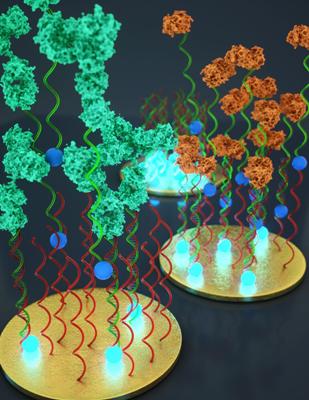Sep 23 2015
Chemists at the University of Montreal used DNA molecules to developed rapid, inexpensive medical diagnostic tests that take only a few minutes to perform. Their findings, which will officially be published tomorrow in the Journal of the American Chemical Society, may aid efforts to build point-of-care devices for quick medical diagnosis of various diseases ranging from cancer, allergies, autoimmune diseases, sexually transmitted diseases (STDs), and many others.
The new technology may also drastically impact global health, due to its low cost and easiness of use, according to the research team. The rapid and easy-to-use diagnostic tests are made of DNA and use one of the simplest force in chemistry, steric effects - a repulsion force that arises when atoms are brought too close together - to detect a wide array of protein markers that are linked to various diseases.
 Professor Alexis Vallée-Bélisle of the University of Montreal and his colleagues have built an inexpensive, portable sensor that enables fast and easy detection of multiple diagnostically relevant proteins (in fewer than 10 minutes.) The sensing principle is straightforward: the diagnostically relevant protein (green or red), if present, binds to an electro-active DNA strand and limits the ability of this DNA to hybridize to its complementary strand located on the surface of a gold electrode. Credit: Ryan & Peter Allen
Professor Alexis Vallée-Bélisle of the University of Montreal and his colleagues have built an inexpensive, portable sensor that enables fast and easy detection of multiple diagnostically relevant proteins (in fewer than 10 minutes.) The sensing principle is straightforward: the diagnostically relevant protein (green or red), if present, binds to an electro-active DNA strand and limits the ability of this DNA to hybridize to its complementary strand located on the surface of a gold electrode. Credit: Ryan & Peter Allen
The design was created by the research group of Alexis Vallée-Bélisle, a professor in the Department of Chemistry at University of Montreal. "Despite the power of current diagnostic tests, a significant limitation is that they still require complex laboratory procedures. Patients typically must wait for days or even weeks to receive the results of their blood tests," Vallée-Bélisle said. "The blood sample has to be transported to a centralised lab, its content analyzed by trained personnel, and the results sent back to the doctor's office. If we can move testing to the point of care, or even at home, it would eliminates the lag time between testing and treatment, which would enhance the effectiveness of medical interventions.
The key breakthrough underlying this new technology came by chance. "While working on the first generation of these DNA-base tests, we realised that proteins, despite their small size (typically 1000 times smaller than a human hair) are big enough to run into each other and create steric effect (or traffic) at the surface of a sensor, which drastically reduced the signal of our tests," said Sahar Mashid, postdoctoral scholar at the University of Montreal and first author of the study. "Instead of having to fight this basic repulsion effect, we instead decided to embrace this force and build a novel signaling mechanism, which detects steric effects when a protein marker binds to the DNA test."
The sensing principle is straightforward: the diagnostically relevant protein (green or red), if present, binds to an electro-active DNA strand, and limits the ability of this DNA to hybridize to its complementary strand located on the surface of a gold electrode. Francesco Ricci, a professor at University of Rome Tor Vergata who also participated in this study, explains that this novel signaling mechanism produces sufficient change in current to be measured using inexpensive electronics similar to those in the home glucose test meter used by diabetics to check their blood sugar. Using this DNA-base assay, the researchers were able to detect multiple protein markers directly in whole blood in fewer than 10 minutes, even if their concentration is 1,000 000 times less concentrated than glucose. "A great advantage of this DNA-based electrochemical test is that its sensing principle can be generalized to many different targets, allowing us to build inexpensive devices that could detect dozens of disease markers in less than five minutes in the doctor's office or even at home," concludes Vallée-Bélisle.
A patent has been submitted for this invention, and many other applications are envisaged, including pathogen detection in food or water and therapeutic drug monitoring at home, a feature which could drastically improve the efficient of various class of drugs and treatments.
Source: http://www.nouvelles.umontreal.ca/